Most aspects of life came to a halt during the 1940s due to one main event. WW2. Everthing throughout this decade was defined by a need to support the war effort.
WW2
1939-1945 changed the whole world. Fighting and recovering from the war defined the decade completely. For most of the war, the allies were losing. Around 70 million people lost their lives during this war. Men were in the army, women were enlisted to take up jobs that men had left or to contribute to the war effort. This more than any other was was all encompassing through all levels of society.
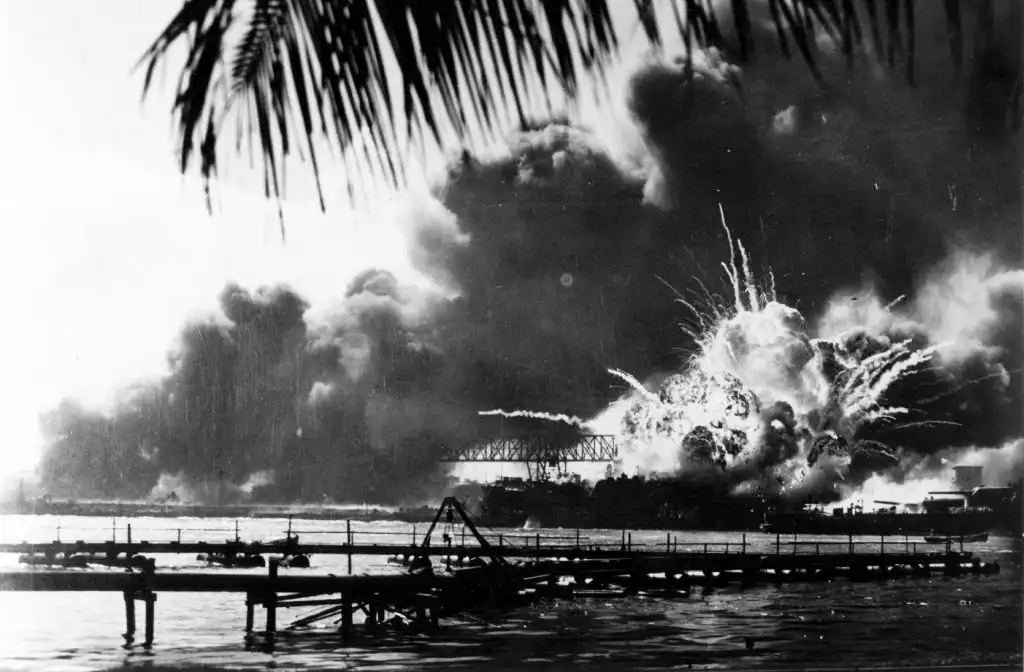
Propaganda
The most prominent artwork during the 1940s was that of the different propaganda machines around the globe.
Women’s at Work
Since men were away at war, women stepped in and took up jobs in factories, military and anywhere else they were needed.
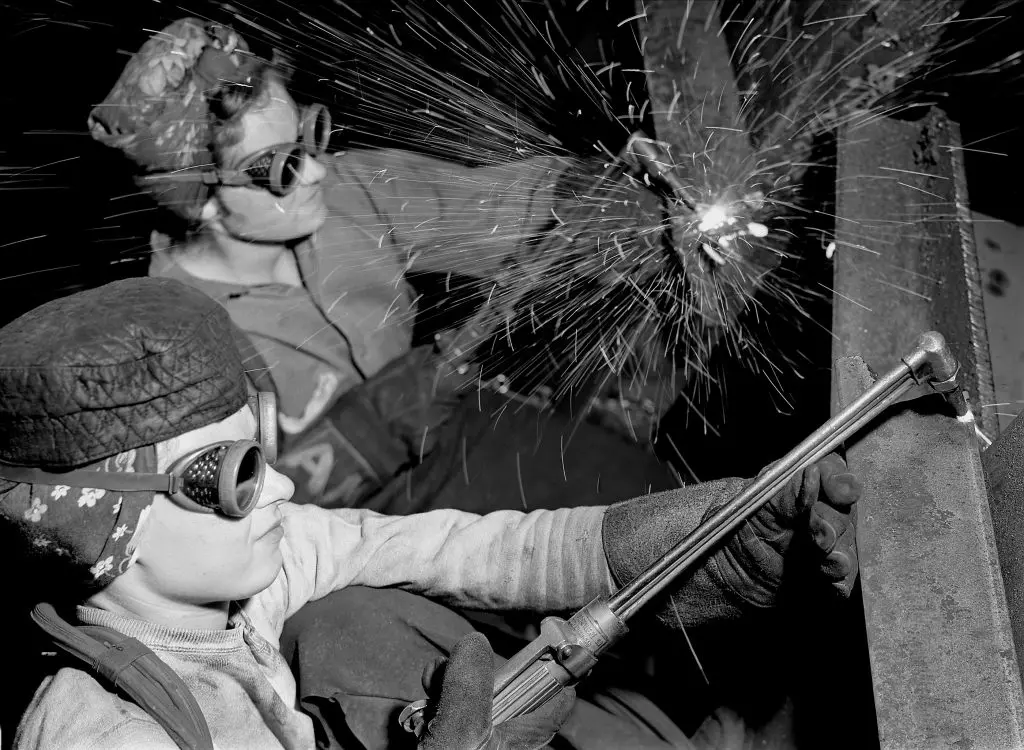
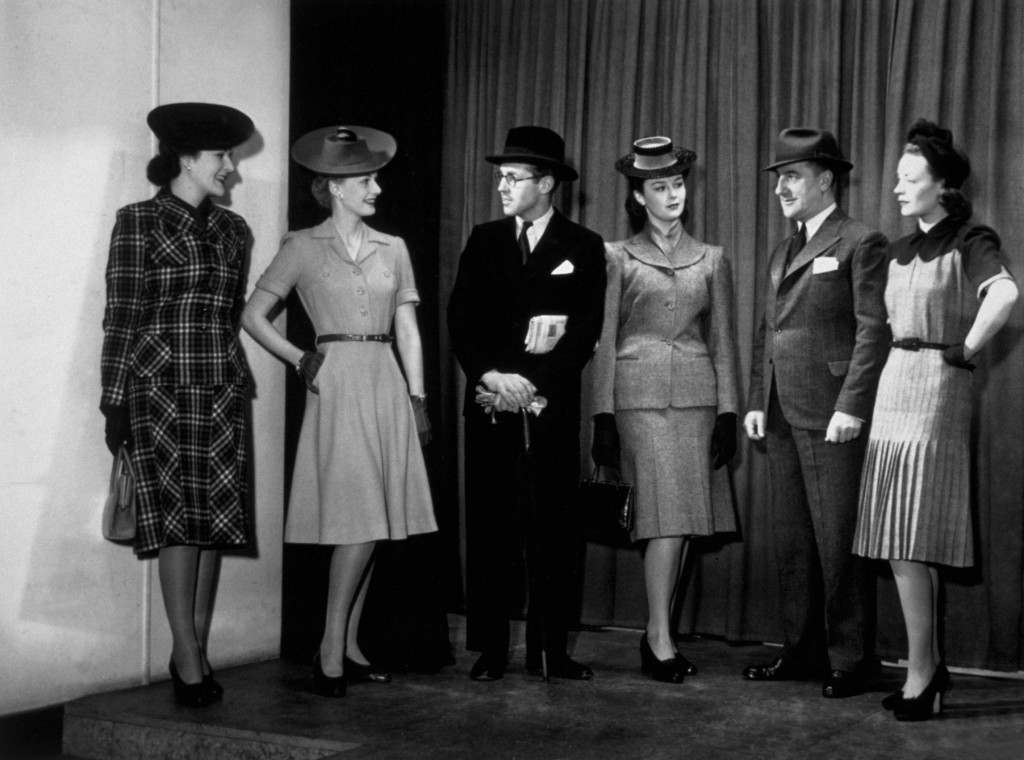
Utility Clothing
An idea born out of clothing rationing in the UK. The governement comissioned Utility Clothing that stuck the the fabric and production limitations during the war effort. The garments were meant to be stylish and versatile as well as durable and long lasting.
Image: Models at Bush House, London. 1942. Keystone
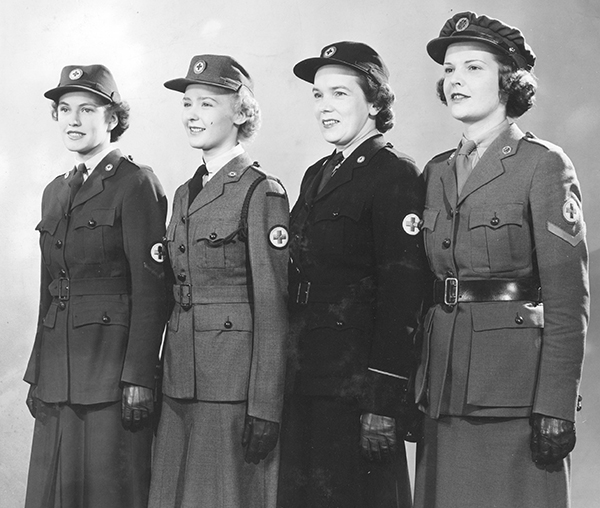
Uniforms
Women also enlisted in the army and other arms of defense or medical assistance. Uniforms were designed to be flattering to the female figure and mostly were designed as a skirt and jacket. It would still have been inappropriate for a women’s uniform to be trousers.
Image: Canadian Red Cross Uniforms during WWII. Redcross.ca
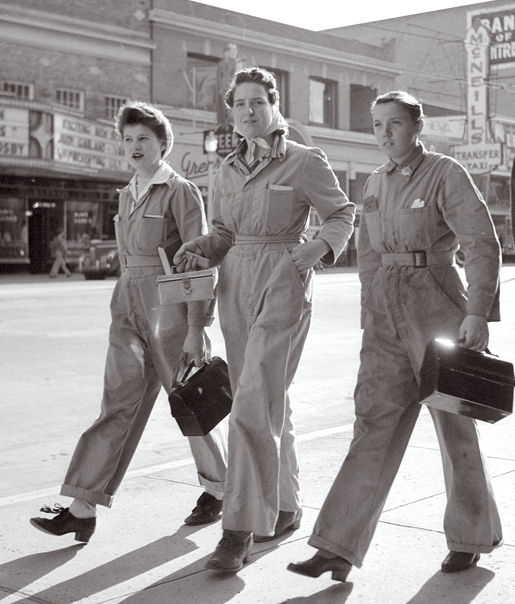
Work wear
The needs of war meant that manufacturing sped up rather than slowed down and it was women who did this work since then men were away. They needed practical garments that kept them safe and allowed them mobility. In this arena, pants or overalls were worn as skirts would have been completely inappropriate. Women often tied their hair up in scarves to keep it away from machinery.
Image: Women walking to work during WW2. History.com
Makeup
Thin Arched brows. Natural eyelashes. Glowing cheeks. Big eyelashes and most importantly red lips. Wearing red lipstick was seen as patriotic in both the USA and the UK. A way of women to look beautiful while doing men’s work. You would think that makeup would lose popularity during the War era, but in fact it was considered a duty of the women taking place in the war effort.
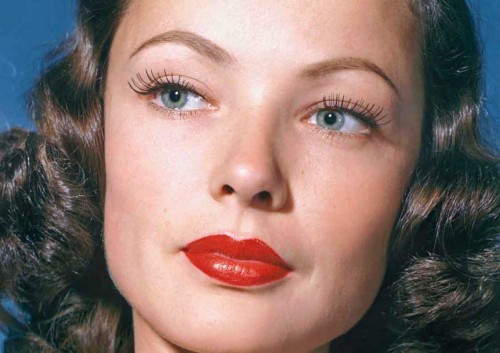
Silhouette
At the start of the 1940s the ideal body type of the time was strong, with broad military shoulders, high breasts, a defined waistline with moulded hips and curvy, muscular legs. This obviously came from the society’s need for women to take on traditionally male jobs and shoulder the manufacturing and economic brunt of the country while the men were away fighting. Military inspired shoulder pads, a trim natural waistline, moulded hips and knee length skirts were popular.
The ideal silhouette changed dramatically after WW2, when Dior released a collection featuring his ‘New Look’. Which was a nostalgic call back to traditional femininity. The New Look was an hourglass silhouette with petite sloped shoulders, large breasts a waspy waist, full skirts and padded hips and hemlines dropping back to mid-calf; a silhouette that hearkened back to the corsetted days of the early 20th century.
One thing that was popular during and after the war were large, dramatic hats!
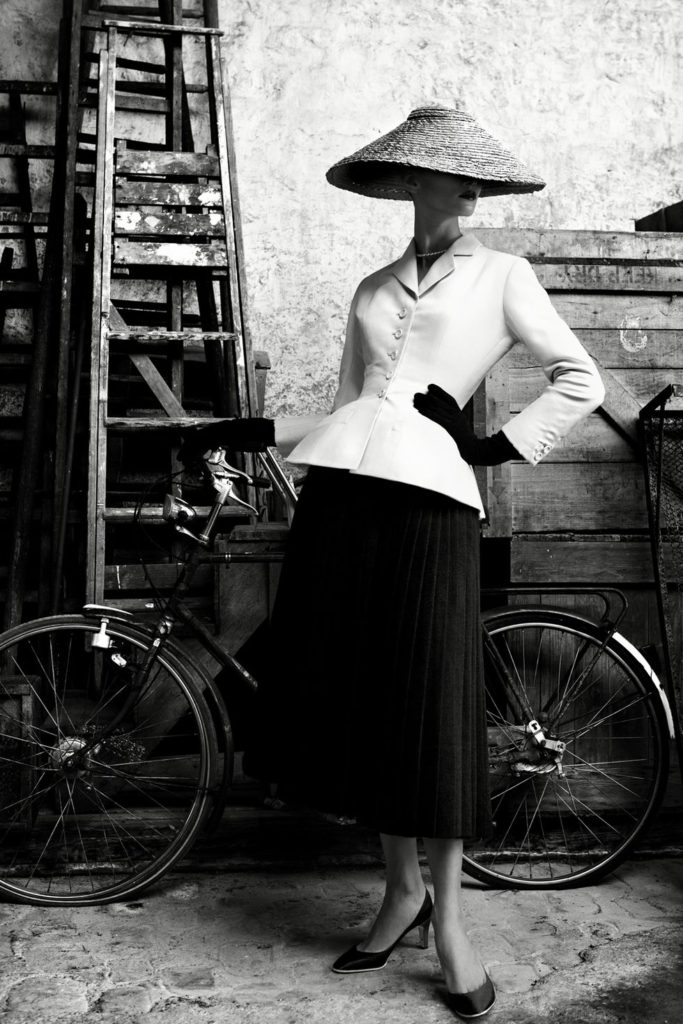
Designer of Note: Christian Dior
The New Look was part of Dior’s S/S ’47 collection. German occupation of Paris would have been a difficult time, and Dior was likely attempting to reclaim Haute Couture. It went along with the idea that after the war women should be returning to the home sphere and allowing men to reclaim their jobs.
Image: The Bar suit, Dior, Corelle Collection. 1947. Harper’s Bazaar
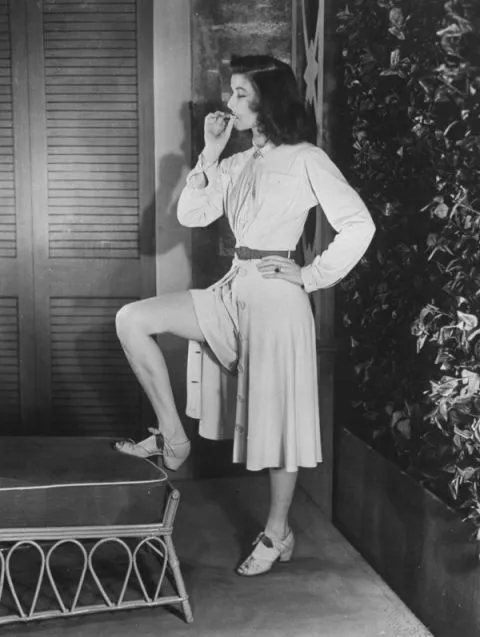
Fashion Icon: Katherine Hepburn
Katherine Hepburn was one of the icons of Hollywood’s heyday and continued her reign throughout the 1940s. She was the picture of a strong american woman and was not afraid to speak her mind.
She was famous at the time for embracing large roomy trousers before it was acceptable and is considered a “pioneer of the american sportswear aesthetic.”
Image: Katherine Hepburn wears a shirtdress over a romper on the set of The Philadelphia Story, 1941. Marie Claire Magazine
Thoughts
Something that really sticks out to me are the two silhouettes of the 1940s. THOUGH I do love the aesthetic of Dior’s New Look, after learning the history, it feels a bit to me as if Dior was just another man trying to put women in their ‘place’ once the need for their help had passed. Yet, like many of the women of that era I am sure, I am much more drawn to the late 1940s outfits than the military structure of the early 1940s. Additionally, we see again cosmetics marketing themselves as something a strong woman must have and beauty as a duty that you owe the public that will be “viewing” you.
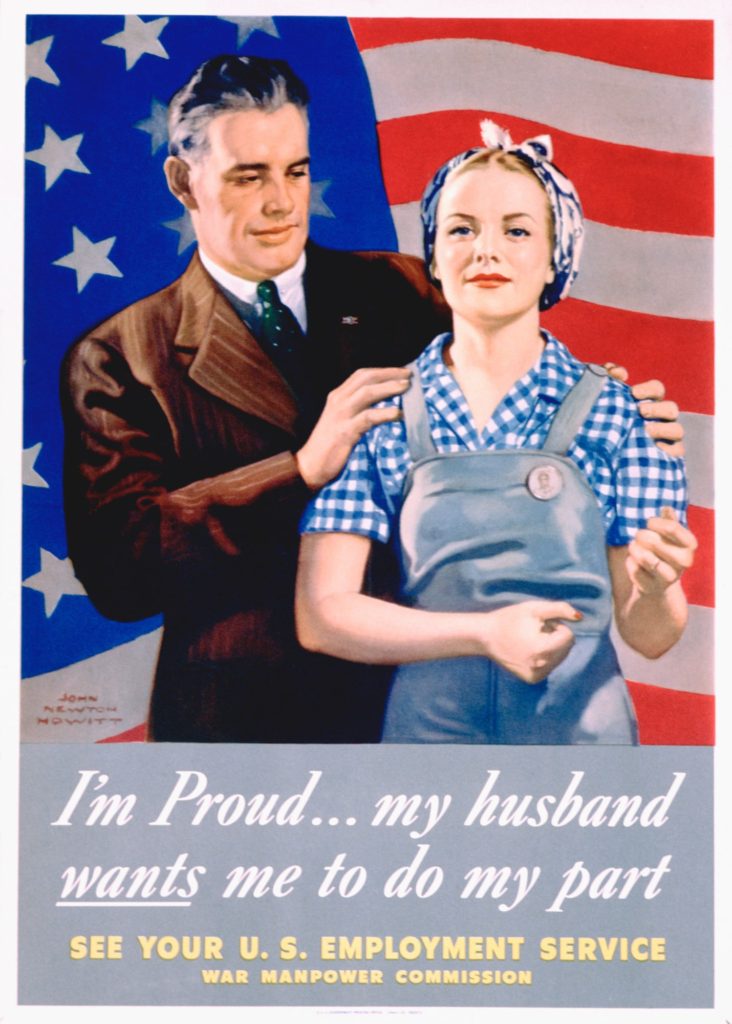
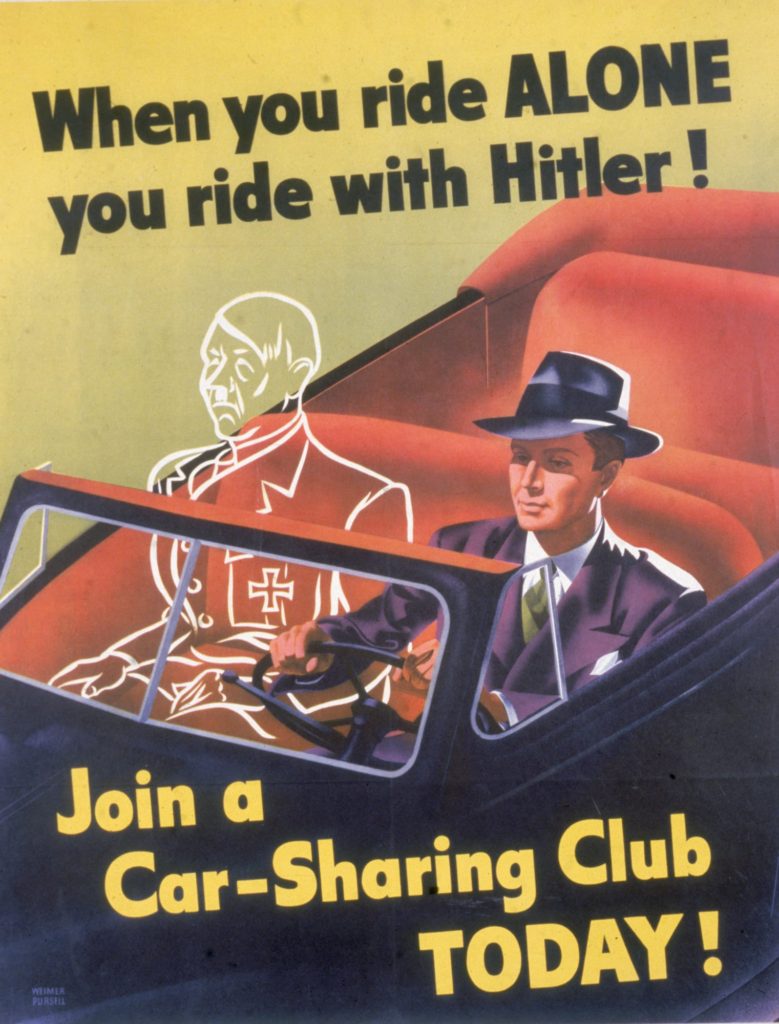
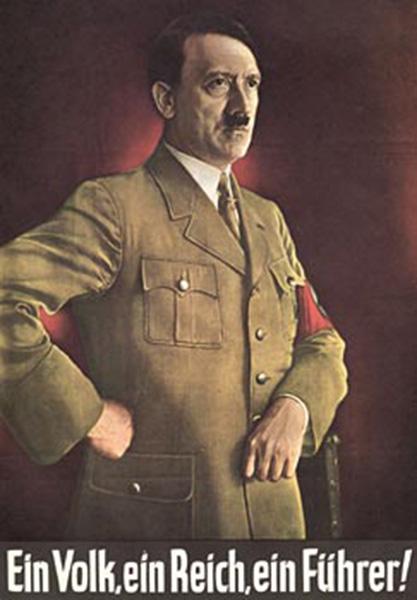
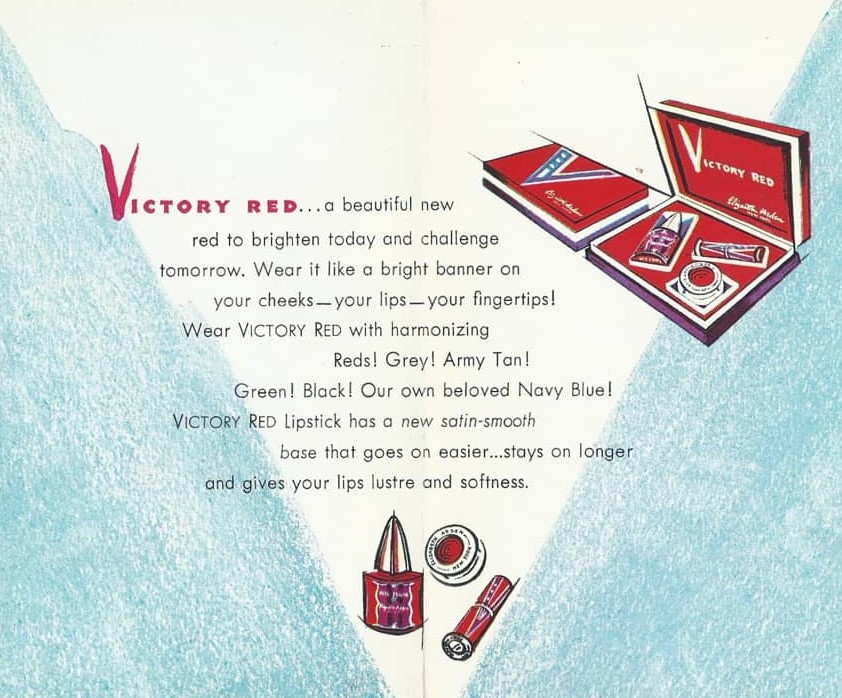
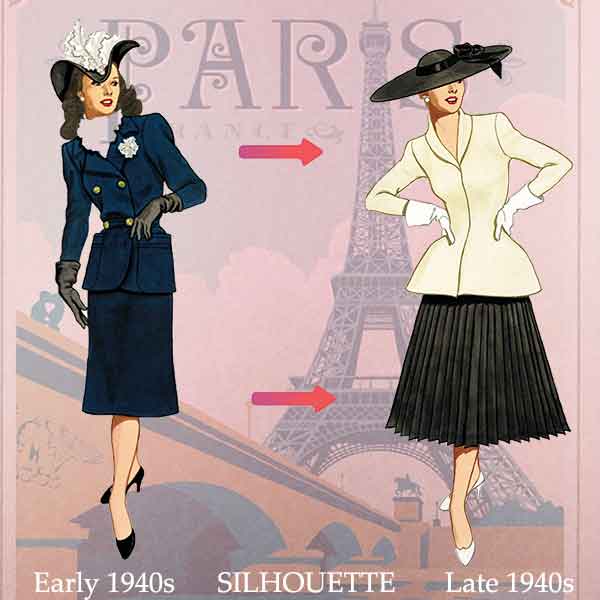
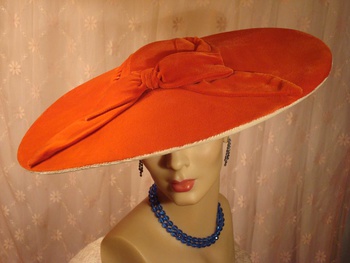
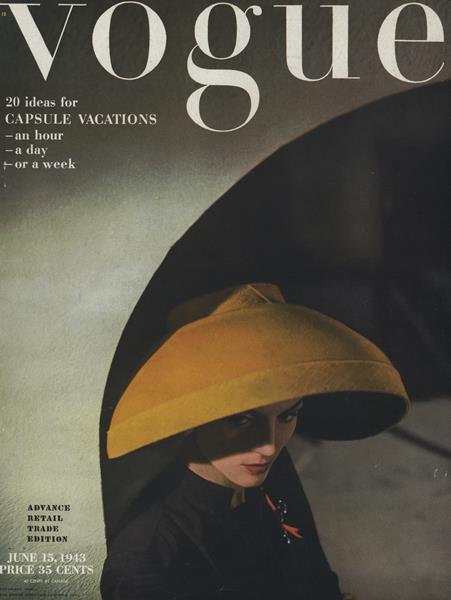
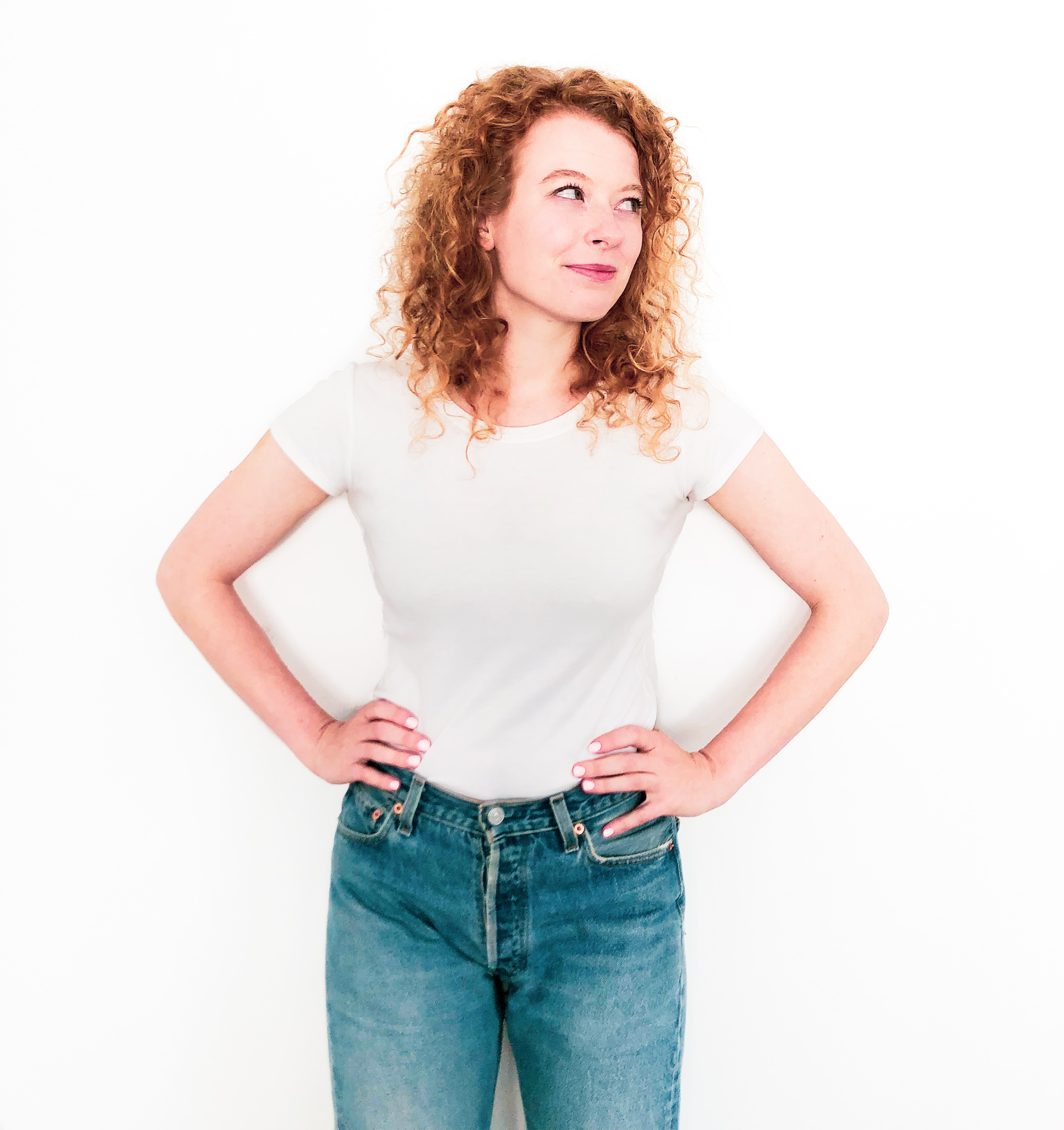
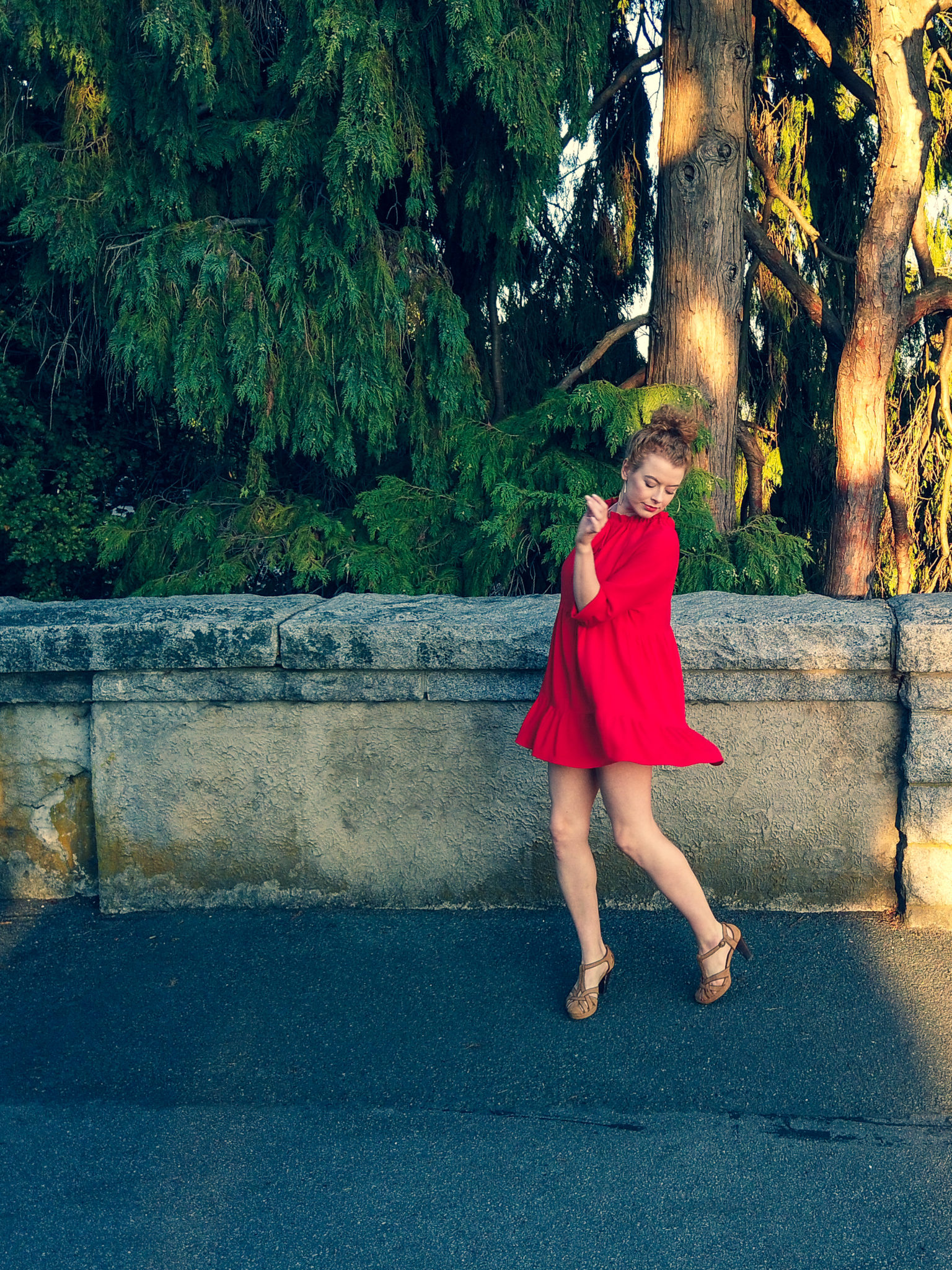
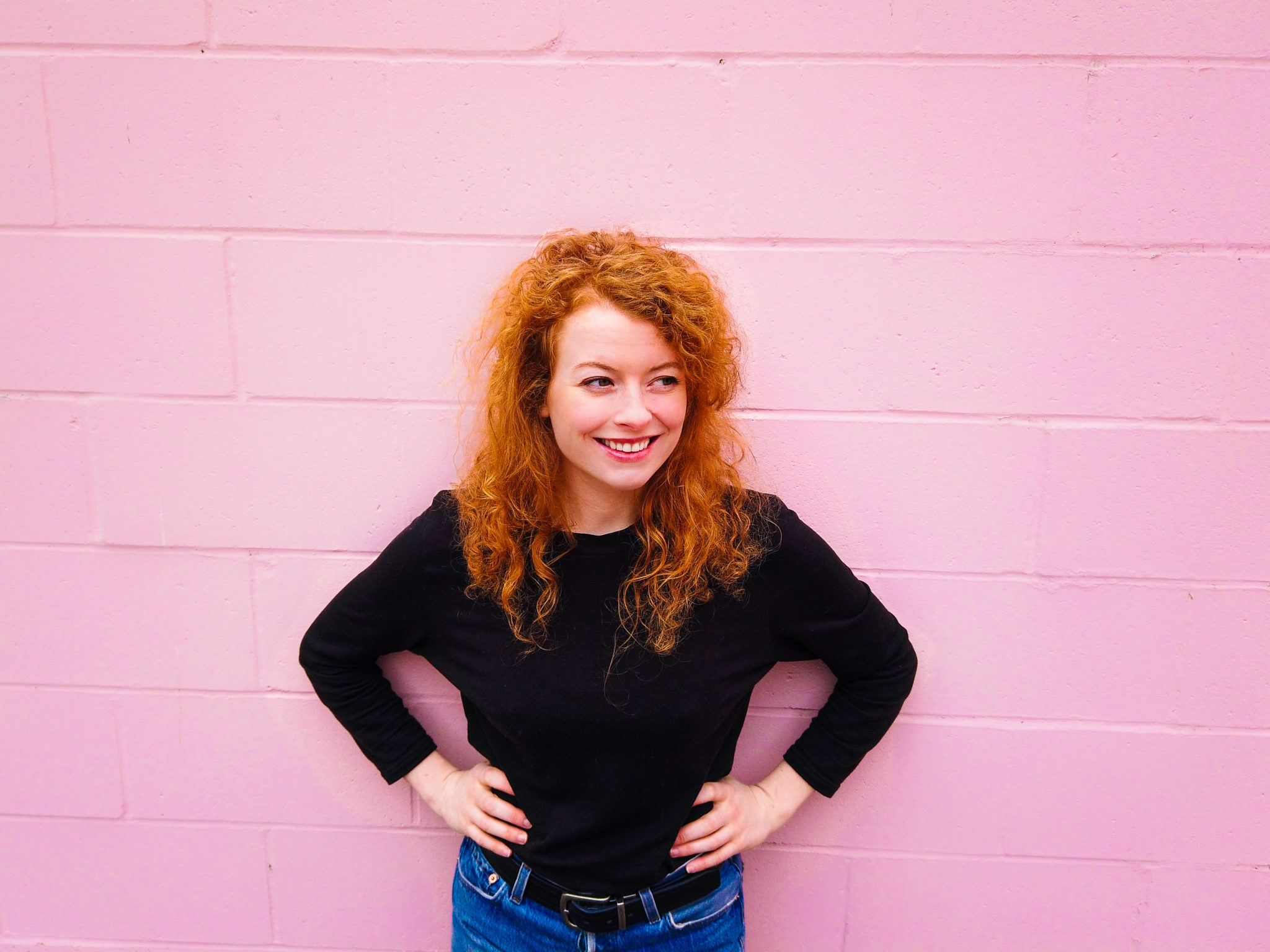
I find the opposite vibe to be more attractive and appealing, than the one you do, but then that’s all that “something for everyone” esthetic.
The clean, trim, attractive designs during the first half of the 40s – the “War Years” -gave women flattering, body skimming designs and bright, patriotic colors to wear, plus the introduction into the closets of pants/trousers/slacks, and even specific designs of “female” overalls, worn with or without their blouses underneath, to be flattering and practical for farm women taking the place of the absent farmhands, plus the city women working in their victory gardens, or even doing the laundry and hanging it out on the washline. The practicality of pants for women also added very acceptable warmth during long, cold, snowy winters, where before dresses were their only socially acceptable option, adding little to nothing to seasonal wintertime comfort. Unless they were quite wealthy, spending winters on the ski slopes.
The iconic shirtdress style, and the two piece suit, were also very popular designs. Depending on the fabric and trims used, the shirtdress could be worn for everything from daily housework, to running errands and shopping on the day off, to having lunch with “the girls” on those rare occasions when time for such things could be scraped out of the busy war-working days.
Knee length Cocktail dresses replaced floor length, more formal styles, using much less fabric, while still becoming the evening wear of choice.
Military uniforms, especially for the women’s Navy, designed by a famous fashion designer, were declared the most attractive uniforms of all the services. They were feminine and conservative, plus being flattering and practical. All the services eventually adopted pants into their accepted and very useful styles. Army, Army Air Corps, and Navy flight nurses all had practical slacks, “Ike” style waist length jackets, low heel, lace up oxfords, plus practical weather appropriate styles added into their kit. Even land based nursing staff stationed overseas had seersucker uniforms, including pants, and dresses, and matching jackets included until several years following the end of the war, when they returned to the traditional all white nurses uniforms and caps.
Nurses stationed Stateside weren’t left out either. Army nurses overseas wore brown and white stripe seersucker, to replace their high maintenance, all white, starched and ironed dress uniforms, (plus white stockings with girdles to hold them up, and white leather shoes,) which were simply impossible to properly maintain in battlefield nursing, while US based staff had blue and white. Navy female staff in most vocational areas, including nursing, were furnished with gray and white for practical, no starch, no iron, easy maintenance. The simple, flattering, designs and practicality inherent in early 1940s styles is what makes them so desirable and iconic even 80 years later, and have seen them make a comeback more than once since then, in my opinion. I wore them on their first style comeback tour in the early to mid 80s, not knowing nearly as much about their first iteration as I do now, but enjoyed them incredibly. I even (accidentally) discovered ’40s Big Band and Swing music at the same time, and found that it struck a chord in me (pun) that I wasn’t even aware existed. I still love it today.
Being an “early American tomboy”, and military aficionado, including a two year stint in AF JROTC in high school, plus being an Air Force wife as a young woman, surely affects my own style sensibilities, and will continue to do so until I am no longer of this world!